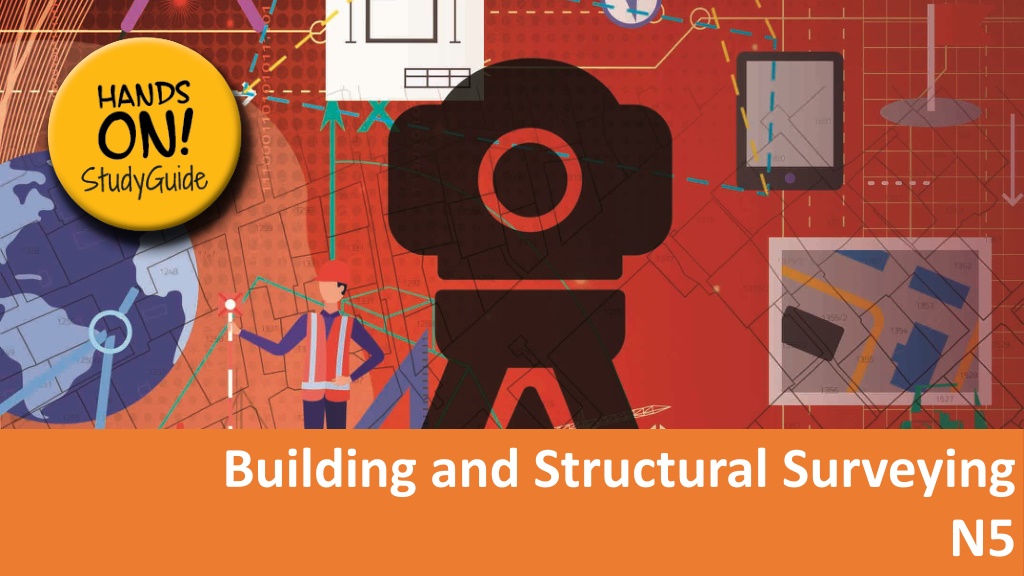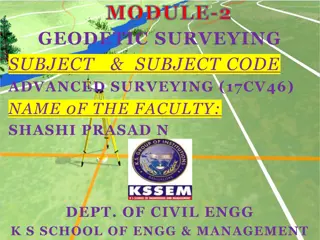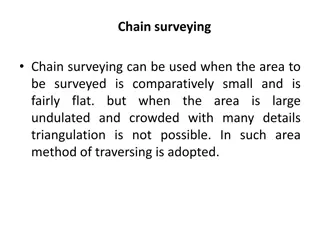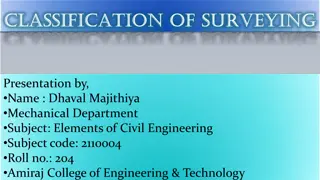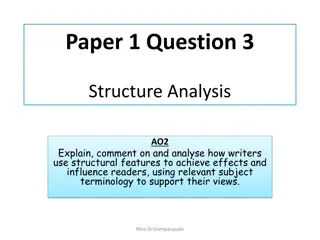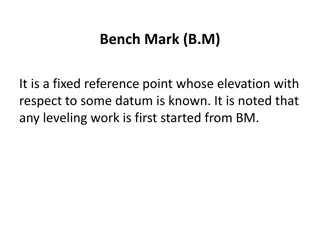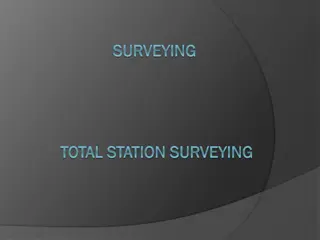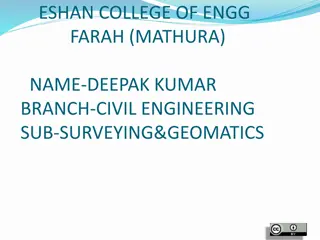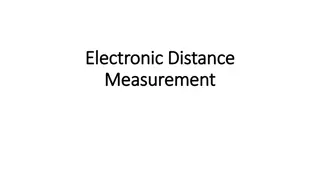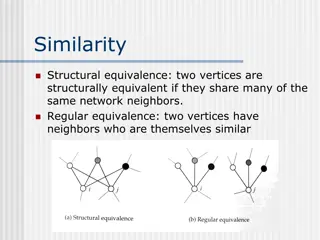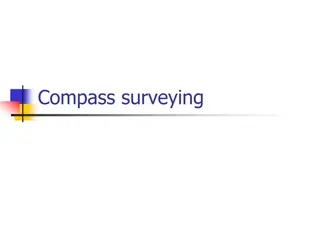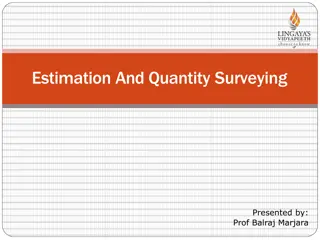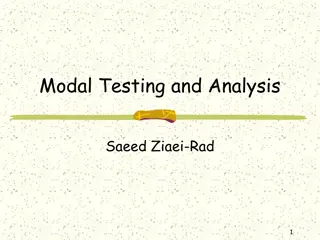Understanding the Basic Principles of Surveying for Building and Structural Projects
Surveying plays a crucial role in ensuring accurate positioning and alignment of structures such as buildings, bridges, and roads. This article delves into the definition of surveying, stages in the surveying process including reconnaissance, field work and measurement, and office work. Understanding these basic principles is essential for professionals in the field of building and structural surveying.
Download Presentation

Please find below an Image/Link to download the presentation.
The content on the website is provided AS IS for your information and personal use only. It may not be sold, licensed, or shared on other websites without obtaining consent from the author. Download presentation by click this link. If you encounter any issues during the download, it is possible that the publisher has removed the file from their server.
E N D
Presentation Transcript
Module 1: Basic principles of surveying INTRODUCTION Surveying ensures that everything is in the right place on the right alignment and where it is intended be. Without surveying, there would be no tall buildings, bridges or roads. It is a service that ensures columns of buildings are plumb, property lines are defined, structures are aligned, estimates are correct, etc. Understanding the basic principles of surveying is therefore essential in order to understand the discipline. www.futuremanagers.com
Module 1: Basic principles of surveying (continued) DEFINITION OF SURVEYING Surveying may be defined as the art of determining the relative positions of points on, above or beneath the surface of the earth with respect to each other by measurement of horizontal distances, vertical distances, angles and directions. www.futuremanagers.com
Module 1: Basic principles of surveying (continued) STAGES IN THE SURVEYING PROCESS Step 1: Reconnaissance (taking a general view) During reconnaissance, the surveyor does an overall inspection of the area to be surveyed to obtain a general picture before commencement of any type of field work and measurement. The surveyor will then select the location for control points and decide on the accuracy required for the control and which survey instruments to use for the project. www.futuremanagers.com
Module 1: Basic principles of surveying (continued) STAGES IN THE SURVEYING PROCESS (CONT.) Step 2: Field work and measurement (observation and measurement) During this stage, the surveyor will perform all the observations required to accurately determine the control points, and will place and observe any temporary points and record all data in the field book. The surveyor will also do any calculations from the observations, such as angular and linear misclosure, and area and volume calculations. www.futuremanagers.com
Module 1: Basic principles of surveying (continued) STAGES IN THE SURVEYING PROCESS (CONT.) Step 3: Office work (presentation of data) At this stage, the data collected and recordings in the field book are decoded and used to prepare the report, bills of quantities, datasheets, drawings and, in land surveying, plans and maps showing the features on the land, which are then presented to the clients and relevant stakeholders. www.futuremanagers.com
Module 1: Basic principles of surveying (continued) FUNDAMENTAL PRINCIPLES OF SURVEYING Surveying, in general, is based on a number of principles: Working from the whole to a part Location of a point by measurement from two points of reference Consistency of work Independent checks Accuracy required. www.futuremanagers.com
Module 1: Basic principles of surveying (continued) ACCURACY AND PRECISION Because no measurement is ever completely accurate, surveyors strive for both accuracy and precision. These words have different meanings to a surveyor. Accuracy refers to how closely a measurement or observation is to measuring a true value, as measurements and observations are always subject to error. Precision refers to how closely repeated measurements or observations come to duplicating measured or observed values. www.futuremanagers.com
Module 1: Basic principles of surveying (continued) ERRORS IN MEASUREMENT Mistakes are avoidable blunders that occur because of carelessness or a temporary mental lapse. They include incorrect readings and booking of observations as well as the use of erroneous data in calculations. There is no law governing the occurrence of mistakes and no observer is beyond making mistakes. www.futuremanagers.com
Module 1: Basic principles of surveying (continued) ERRORS IN MEASUREMENT (CONT.) Constant errors are errors that, in all measures under the same circumstances, have the same magnitude and algebraic sign. The errors can be caused by either the apparatus itself or external circumstances to the apparatus. Examples of constant errors are: measuring with a tape that is too long or too short; and using a theodolite or dumpy level with a collimating error. www.futuremanagers.com
Module 1: Basic principles of surveying (continued) ERRORS IN MEASUREMENT (CONT.) Systematic errors are caused by the surveying equipment, observation methods, and certain environmental factors such as variations in temperature, humidity, pressure, current velocity, curvature, and refraction. Under the same measurement conditions, these errors will have the same magnitude and direction (positive or negative). Because systematic errors are repetitive and tend to accumulate in a series of measurements, they are also referred to as cumulative errors. www.futuremanagers.com
Module 2: Linear measurements INTRODUCTION Distance measurement is considered to be the most fundamental of all surveying operations. It is a process of measuring distances between points on a surface using a chain or tape. It is done based on the linear surveying principle that states: if the distance between two points is measured, the points are fixed. This module details the methods of overcoming field challenges and plotting of chain surveys. www.futuremanagers.com
Module 2: Linear measurements (continued) ERRORS IN MEASUREMENT AND CORRECTIONS To compensate for the unavoidable errors in measurement, it is generally necessary to apply corrections to measurements made by direct linear methods. www.futuremanagers.com
Module 2: Linear measurements (continued) LINEAR MEASUREMENT OBSTACLES Linear measurement lines should, as far as possible, be arranged to avoid obstacles. However, occasionally obstacles are unavoidable, even after a careful preliminary survey. The following are some of these obstacles: Measuring a horizontal distance on a slope Measuring slope angle using a clinometer Measuring around a pond or across a river or a busy road Measuring when a building obstructs vision. www.futuremanagers.com
Module 2: Linear measurements (continued) CHAINING OR TAPING Surveying lines are measured using a chain or tape as the principal instrument for the accurate determination of lengths. www.futuremanagers.com
Module 2: Linear measurements (continued) PLOTTING SURVEYS Plotting means to represent on paper, to a suitable scale, the previously surveyed objects in accordance with their shape and size. Plotting commences after the field work has been completed. www.futuremanagers.com
Module 2: Linear measurements (continued) COORDINATES Coordinates are figures that indicate the distance of the location of a concern from the two coordinate axes. They are used to describe the exact position of a location on the ground, or on a map or plan. www.futuremanagers.com
Module 3: Height measurement INTRODUCTION Height, or orthometric height, refers to elevation which is defined as the vertical distance along the plumb line, from a point of interest to a reference surface known as the geoid (an imaginary mean sea level surface). The process of measuring height is called levelling. This module will detail the method involved in measuring, recording and reducing the measurement to establish the position of points on the earth s surface. www.futuremanagers.com
Module 3: Height measurement (continued) LEVELLING TERMINOLOGY The various important terms to remember in levelling are: Planes (horizontal, vertical and incline) Direction of gravity Level surface Collimation line Change point (CP) www.futuremanagers.com
Module 3: Height measurement (continued) DEFINITION AND PURPOSE OF LEVELLING Levelling means determining the relative elevations or heights of points using a Levelling means determining the relative elevations or heights of points using a dumpy level or automatic level. dumpy level or automatic level. Levelling is done for all important engineering works and construction projects. www.futuremanagers.com
Module 3: Height measurement (continued) DIFFERENTIAL LEVELLING Differential levelling is a technique used to determine differences in elevation between points that are distant from each other. It requires the use of a surveyor s level together with a levelling staff. www.futuremanagers.com
Module 3: Height measurement (continued) TRIGONOMETRIC LEVELLING Trigonometric levelling is a process of levelling in which the elevation of points or the difference in height between points is measured from the observed horizontal distances and vertical angles in the field. The trigonometric relations are then used to find the elevation of a point from the angle and horizontal distance. www.futuremanagers.com
Module 3: Height measurement (continued) BAROMETRIC LEVELLING Barometric levelling is a type of indirect levelling method in which the differences in the elevation of points are determined from differences in atmospheric pressure observed with altimeters or barometers at each point. www.futuremanagers.com
Module 3: Height measurement (continued) LEVELLING INSTRUMENTS Levelling staff a straight rod, rectangular in cross-section and graduated in metres and millimetres. Wye level a surveyor s levelling instrument that consists of a telescope mounted on two Y-shaped supports and a spirit level mounted under and parallel to the telescope. www.futuremanagers.com
Module 3: Height measurement (continued) LEVELLING INSTRUMENTS (CONT.) Cooke s reversible level a combination of a dumpy level and a Y-level Cushing s level a levelling instrument in which the telescope is rigidly fixed in the collar, as in a dumpy level Staff bubble a small, circular bubble on an angle plate that is held against one corner of the staff www.futuremanagers.com
Module 3: Height measurement (continued) LEVELLING INSTRUMENTS (CONT.) Change plate a triangular steel plate with a pin at the centre and three corners turned down; it is used to mark the change point position of the staff and to prevent the staff from sinking Traveller (or boning rod) used to control an excavation to ensure that it has a uniform depth and is sometimes used with a sighting rail when excavating trenches for drainage pipes www.futuremanagers.com
Module 3: Height measurement (continued) LEVELLING INSTRUMENTS (CONT.) Dumpy level provides an accurate line of sight that enables it to be used over long distances for setting up benchmarks for levelling Tripod a stand that consists of three legs that are solid-framed; it is used to hold the instrument while surveying Theodolite ideal for tacheometric and traverse surveying, but not for differential surveys www.futuremanagers.com
Module 3: Height measurement (continued) LEVELLING INSTRUMENTS (CONT.) Tilting level a level used for precise levelling work Automatic level useful in series levelling because it has a compensator which keeps the telescope level www.futuremanagers.com
Module 3: Height measurement (continued) CLASSIFICATION OF A LEVEL TRAVERSE A level traverse is a series of levels carried out in order to determine the difference in levels between points on the surface of the ground. It is also called a level run. Level traverses can be classified as closed or open traverses. A closed level traverse is a series of level runs from a known datum or reduced level. There are two types of closed traverses, namely closed link and closed loop traverses. www.futuremanagers.com
Module 3: Height measurement (continued) ERRORS IN LEVELLING Errors in levelling are classified as instrumental, personal or natural. They can be reduced by careful adjustment, establishment of field procedures and adhering to these procedures, but they cannot be eliminated. www.futuremanagers.com
Module 3: Height measurement (continued) FLY LEVELLING Fly levelling is used for transferring levels and the only readings required are the backsight and foresight recordings. The intermediate sight readings are not used, but the distance between readings should not exceed 50 m. Fly levelling can be helpful when the benchmark is very far from the workstation. www.futuremanagers.com
Module 3: Height measurement (continued) SERIES LEVELLING Series levelling is used to determine the difference in level between points on the surface of the ground, and the readings required are backsight, foresight and intermediate sight readings. www.futuremanagers.com
Module 3: Height measurement (continued) RISE AND FALL METHOD In this method, the difference in level between two consecutive points for each instrument set up is obtained by comparing their staff readings. The difference between their staff readings indicates a rise if the backsight staff reading is more than the foresight and a fall if it is less than the foresight. The algebraic sum of rises and falls gives the difference in level between the starting and closing points. www.futuremanagers.com
Module 3: Height measurement (continued) COLLIMATION HEIGHT METHOD In this method, the instrument height is calculated for the first instrument set up by adding the backsight to the reduced level of the given benchmark. The reduced level of the first station is obtained by subtracting its foresight from the instrument height. www.futuremanagers.com
Module 3: Height measurement (continued) CROSS-SECTION LEVELLING Cross sections are vertical sections of the Earth s surface taken at right angles to the main survey line or longitudinal section. They are used in construction work such as that of roads, water channels, and railways. The principal purpose is to provide data so that the depth of fill or cut required to bring the existing surface up or down to the elevation required for the project, can be determined. www.futuremanagers.com
Module 4: Angular measurement INTRODUCTION Measurement of angles is an integral part of surveying. Initially, surveyors used the compasses to define direction, by putting the survey on a magnetic meridian. Theodolites were developed to allow more accurate measurement of angles, both vertical and horizontal. This module will detail the instrument and method involved in taking and reducing these measurements. www.futuremanagers.com
Module 4: Angular measurement (continued) PURPOSE OF ANGULAR MEASUREMENT Horizontal and vertical angles are fundamental measurements in surveying. The vertical angle is used to obtain the elevation of points and in the reduction of sloping distance to the horizontal. The horizontal angle is used primarily to obtain bearing and direction to a survey control point, topographic detail points, points to be set out or points to be surveyed. www.futuremanagers.com
Module 4: Angular measurement (continued) PURPOSE OF ANGULAR MEASUREMENT (CONT.) Vertical angular measurements are measured to determine the slope lines from the horizontal plane or level line. Vertical angles are angles measured on a plane perpendicular to the horizontal plane or the plane parallel to the plumb line. www.futuremanagers.com
Module 4: Angular measurement (continued) CLASSIFICATION OF THEODOLITES Theodolites are classified based on the following the movement of the on the horizontal axis in a vertical plane and the arrangement for measuring the angles. www.futuremanagers.com
Module 4: Angular measurement (continued) CLASSIFICATION OF THEODOLITES (CONT.) Transit- and non-transit theodolites are thus classified based on the movement of the telescope on the horizontal axis in a vertical plane. Vernier- and micrometertheodolites that are so classified based on certain arrangements in the way angles are measured. One uses a vernier and the latter uses a micrometer for these measurements. www.futuremanagers.com
Module 4: Angular measurement (continued) THEODOLITE TERMINOLOGY Centering the process of setting up a theodolite on a ground station Vertical axis the axis about which the instrument rotates in a horizontal plane Horizontal axis the axis of rotation of the telescope in the vertical plane, also known as the trunnion axis Circle left (CL) also known as face left; refers to the situation when the vertical circle of the instrument is on the left of the observer when the reading is taken www.futuremanagers.com
Module 4: Angular measurement (continued) THEODOLITE TERMINOLOGY (CONT.) Circle right (CR) also known as face right; refers to the situation when the vertical circle of the instrument is on the right of the observer when the reading is taken Changing face the operation of bringing the vertical circle from one side of the observer to the other side of the observer Swinging the telescope the process of rotating the telescope about the vertical axis in the horizontal plane www.futuremanagers.com
Module 4: Angular measurement (continued) THEODOLITE TERMINOLOGY (CONT.) Transiting the telescope the process of turning the telescope through 180 in the vertical plane about its horizontal axis object glass and the optical centre of the eyepiece Axis of the bubble tube an imaginary line tangential to the longitudinal curve of the bubble tube, at its midpoint Bisecting a point or station when the vertical hair of the telescope lies in the middle of the ranging rod placed at the survey station being observed www.futuremanagers.com
Module 4: Angular measurement (continued) COMPUTATION OF HORIZONTAL ANGLES Suppose that the direction from point A to a point B has to be measured. Set up the theodolite at station A, remembering to check for parallax before any measurement is performed. Once the parallax is removed, bisect point E with a certain circle reading, sight as close to the bottom of the ranging rod at B as possible to eliminate any errors caused by non-verticality of the rod and note the reading as circle left. www.futuremanagers.com
Module 4: Angular measurement (continued) COMPUTATION OF HORIZONTAL ANGLES (CONT.) Change the face of the telescope to get the circle right reading and note the reading. The mean direction is then calculated using the following formula: When the circle right is smaller than 180 , then 180 is added to circle right, and when the circle right is greater than 180 , then 180 is subtracted from circle right. www.futuremanagers.com
Module 4: Angular measurement (continued) COMPUTATION OF VERTICAL ANGLES A vertical angle is an angle between the horizontal line and the inclined line of sight. When it is below the horizontal line, it is called the angle of elevation. When it is below the line of sight, it is called the angle of depression. During computation, if the vertical angle is positive, it is called the angle of elevation. If it is negative, it is called the angle of depression. To eliminate errors, a vertical angle should be observed with circle left and circle right, and the mean of the value computed. www.futuremanagers.com
Module 4: Angular measurement (continued) TACHEOMETRY Tacheometry is a branch of surveying in which the horizontal and vertical distances are determined by angular observation using a tacheometer. www.futuremanagers.com
Module 4: Angular measurement (continued) USES OF TACHEOMETRIC SURVEYING Tacheometric surveying is used for the following: Preparing topographic maps or plans where both horizontal and vertical distances are required; Determining differences in elevation between points; Measuring the lengths of traverse lines; and Locating details for hydrographic survey. www.futuremanagers.com
Module 5: Building surveys (continued) BUILDING REGULATIONS AND BUILDING CONSTRUCTION PRACTICE Building regulations exist to ensure that buildings are designed and constructed in accordance with the building regulations and related legislation. These regulations set national standards for building work. They cover all aspects of construction, including foundations, damp-proofing, building stability, insulation, ventilation, heating, fire protection and facilities for disabled people in certain types of buildings. Construction companies carrying out building work must comply with the building regulations. www.futuremanagers.com
Module 5: Building surveys (continued) BUILDING CODES Building codes are regulations governing the design, construction, alteration and maintenance of structures. They specify the minimum requirements to safeguard the health, safety and welfare of buildings occupants. They are enforced to make buildings safer to withstand earthquakes and other natural disasters. www.futuremanagers.com
